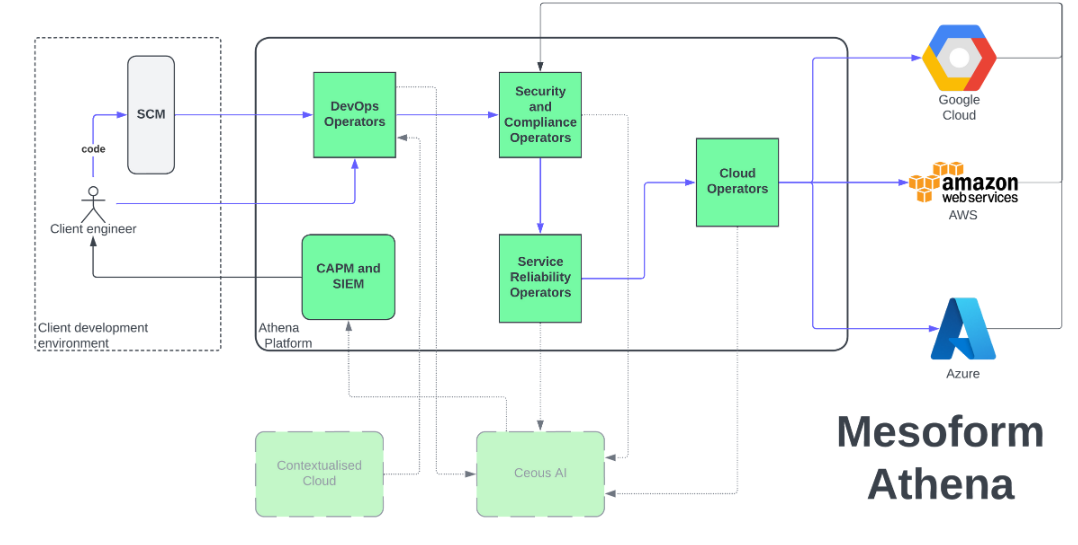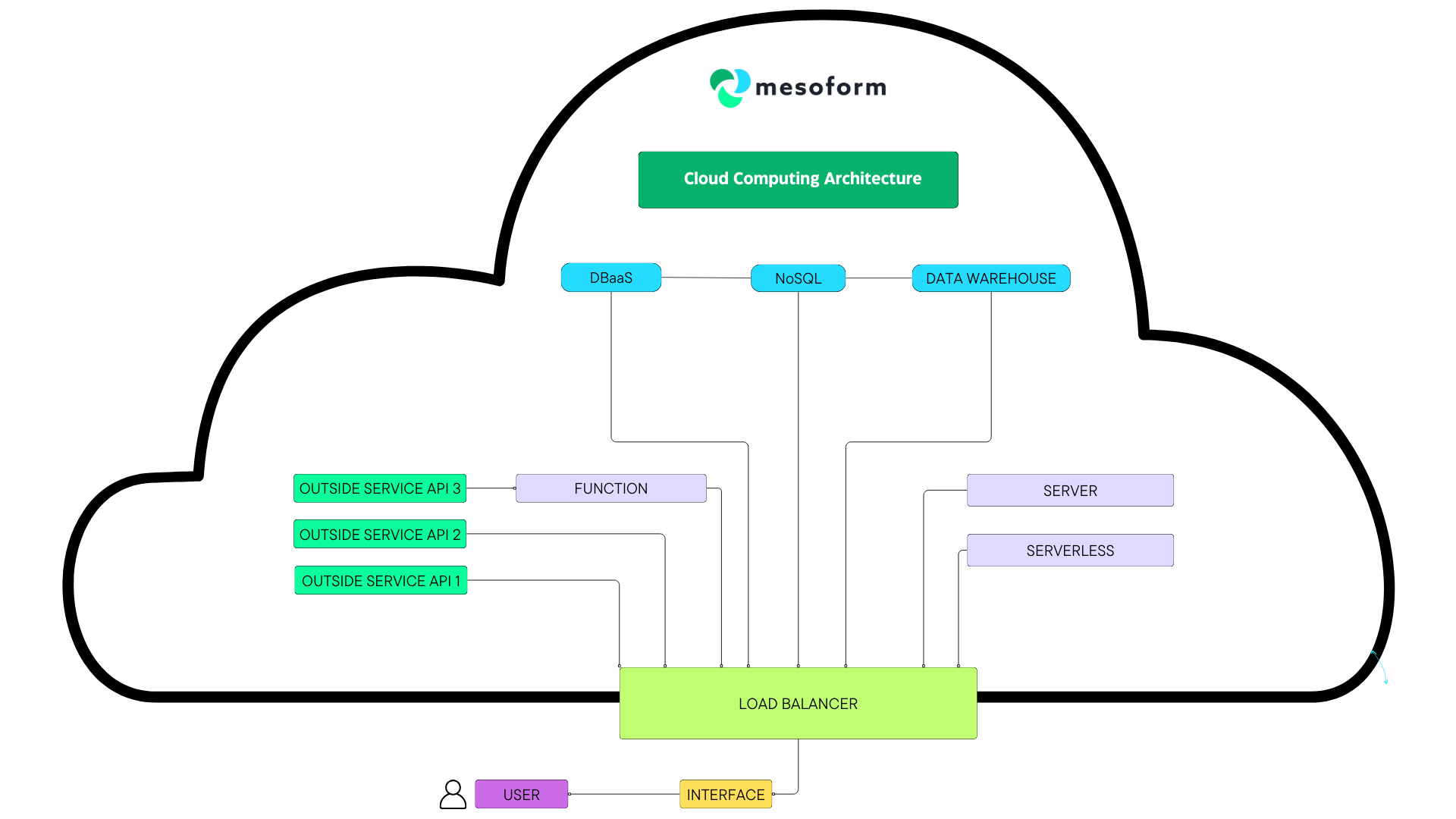Many organisations, particularly those in growth phases, face challenges managing cloud services efficiently. They struggle with high platform maintenance costs and the need for DevOps or SRE engineers. Others hastily adopt cloud solutions via basic "quick start" guides, neglecting maintenance, under the assumption that "it just works." Both approaches often lead to wasted resources, service outages, or security breaches, diverting focus and funds from core products.
Mesoform Athena is a multi-cloud developer platform that unifies diverse Cloud Service Provider (CSP) offerings into a user-friendly controller. It streamlines access control, security, compliance, software delivery, and event monitoring while adding innovative features for an enhanced experience. Leveraging advanced technology, Athena offers a "single pane of glass" for secure, efficient, and cost-effective cloud management. Backed by two decades of enterprise expertise, Mesoform ensures continuous updates and resolves complex issues, eliminating user hassle.
The high level design looks like this:

But how does Athena relate to the concept of Shifting Down?
Shifting Down: Simplifying Multi-Cloud Complexity
Instead of adding to developers' cognitive burden by shifting more and more tasks to their workload (as is the case with traditional "Shift Left" strategies), Athena follows the principles of Shifting Down by offloading operational complexities to the platform itself. Here's how:
1. Platform Engineering Focus
Athena is essentially a Platform-as-a-Service (PaaS) that automates the underlying infrastructure management and security layers, allowing domain experts to focus on maintaining and optimising the platform. This means developers don’t have to concern themselves with setting up infrastructure or learning the ins and outs of cloud security—it's all abstracted.
2. Maximising Abstractions and Minimising Cognitive Load
One of the core principles of Shifting Down is reducing the cognitive load on developers. Athena does this by abstracting the complexities of managing multiple cloud environments (AWS, Azure, Google Cloud). Developers interact with a simplified interface, meaning they don't need to become experts in cloud-specific tools or configurations. Athena’s automated security measures ensure best practices are always enforced, further reducing the mental overhead associated with compliance and security.
3. Streamlined Security and Compliance
By integrating automated security and compliance checks directly into the platform, Athena shifts security and governance concerns to the platform level. Developers are no longer required to keep up with the latest in cybersecurity policies or compliance standards (like GDPR)—these are baked into the platform, ensuring your infrastructure stays secure and compliant out-of-the-box.
4. Focus on Innovation, Not Operations
By allowing Athena to handle operational tasks like monitoring, automated remediation, and workload orchestration, engineers can concentrate on coding and innovation—which is why they became developers in the first place. This creates a more satisfying work environment while boosting productivity and creativity.
Key Features of Athena That Exemplify Shifting Down
1. Unified Multi-Cloud Orchestration
Managing workloads across AWS, Azure, and Google Cloud has never been easier. Athena provides a unified interface that simplifies cloud management, eliminating the need to switch between multiple cloud consoles. The complexity of handling cloud-native features such as serverless or containerised applications is abstracted through Athena’s platform.
2. Real-Time Observability and Optimisation
Athena offers real-time monitoring and observability tools, allowing developers to gain insights into infrastructure health and application performance. These tools are automatically set up when a new service is deployed, meaning developers no longer need to configure monitoring or logging systems manually.
3. Cost Optimisation
One of the challenges of multi-cloud architectures is cost management. Athena not only simplifies workload deployment but also offers insights into resource utilisation and cost. Engineers can fine-tune their services based on these insights, optimising both performance and cost-efficiency without needing to spend time manually analysing cloud billing.
4. Automated Security and Compliance Checks
Athena’s platform integrates security best practices into every aspect of the cloud management process, from data encryption to access controls. These security features are kept up-to-date with the latest standards, so developers can be confident that they’re not vulnerable to new threats or compliance lapses.
5. No-Code Cloud-Native Practices
Cloud-native practices like serverless and containerisation are automatically applied by Athena, using pre-built configurations and no-code deployment options. This allows developers to leverage cloud-native advantages without needing deep expertise in underlying infrastructure or DevOps principles.
Benefits of Shifting Down with Athena
Athena's approach to multi-cloud management embodies the key advantages of Shifting Down, providing a more efficient and streamlined development experience. Here are some of the core benefits:
- Reduced Cognitive Load: Developers focus on delivering quality code without worrying about infrastructure management or security policies.
- Higher Job Satisfaction: With fewer distractions and more time for coding, developers experience a greater sense of fulfillment.
- Increased Productivity: Automating operational tasks allows teams to iterate faster and ship software more quickly.
- Consistency and Best Practices: By offering opinionated frameworks and automated security, Athena ensures consistency across projects.
- Improved Security: Built-in security practices guarantee that apps are compliant and protected from the get-go.
- Faster Time-to-Market: By offloading non-functional concerns, developers can deliver projects within tighter timelines.
Conclusion
The Athena Developer Platform exemplifies the principles of Shifting Down by abstracting multi-cloud complexity and allowing developers to focus on what they do best—writing code and delivering innovative solutions. With platform engineering, automated security, and observability baked into the core of Athena, the platform revolutionises how organisations manage and deploy across multi-cloud environments.
Shifting Down with Athena doesn't just simplify development; it opens the door to accelerated innovation, better security, and a seamless multi-cloud experience—allowing companies like yours to focus on what matters most: their product and their users.
In the ever-evolving landscape of IT and cloud services, Athena stands as a beacon of innovation, poised to redefine how businesses approach cloud deployment, security, and efficiency. By embracing both "Shifting Left" and "Shifting Down" methodologies, Athena empowers organisations to navigate the perils of modern cloud management with confidence and excellence. For further insights, explore our in-depth analysis on Shifting Left vs. Shifting Down here https://www.mesoform.com/blog/review/shifting-left-vs-shifting-down
The Mesoform team has been providing platform engineering, DevOps and site reliability solutions for nearly two decades and has worked with startups and some of the largest companies on the planet in doing so. Shifting down (or service oriented organisation as we've previously called it) is exactly we've been doing for at-least the last decade. This experience and expertise places Mesoform in a unique position to enable businesses to adopt a shift down approach quickly and easily and with significantly reduced challenges and deliberations. If you would like to discuss any of these topics in more detail, please feel free to get in touch




